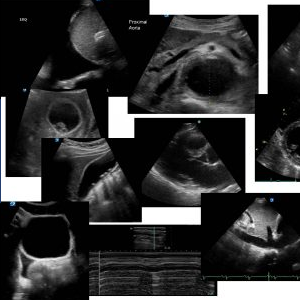
Images and text by Genevieve Carbonatto
Case history
A 42 year old man presented to the Emergency department at 4.00 am with a history of sudden onset central abdominal pain since 2.00 am. The pain was constant, in fact, it was getting worse. It was not associated with vomiting. He had opened his bowels 4 times since he developed abdominal pain.
He had a past history of chronic diarrhea the cause of which was unknown and previous colonoscopies were unremarkable
On examination
He had a very tender abdomen especially in the RIF, with percussion tenderness and rebound tenderness.
An ultrasound was immediately performed at the bedside. In the RUQ, a mass was visible in the transverse plan


The crescent sign refers to the shape of the intussusception in the transverse view. The crescent is formed by the mesentery which is dragged into the intussusception . Because it is found to one side of the bowel it forms an echogenic crescent shape.


The doughnut sign or target sign refers to the alternating echogenic (mucosa and muscularis)) and hypoechoic (submucosa) concentric bands which are caused by the invagination of the bowel
If you look carefully at this clip you can see the classic “doughnut” or target sign of intussusception. In the centre of the doughnut, bowel (the invaginated segment) is seen protruding.
In the longitudinal plane, closer to the junction of the ileum with the ascending colon, the ilium is seen invaginated within the ascending colon


Sandwich sign : 3 parallel hypoechoic lines seperated by 2 nearly parallel hyperechoic bands

Pseudo kidney : This is a longitudinal and slightly oblique view of the intussusception. The hyperechoic centre is due to mensenteric fat and vessels of the intussusceptum.
The longitudinal plane in the same region shows an immobile colon and the pseudo – kidney or hay fork sign
In the RIF, the small bowel demonstrates peristalsis, contrasting sharply with the ascending colon which is almost completely immobile. Gut ischaemia has produced inflammatory changes and there is intraperitoneal fluid.
His CT showed a complex right iliac fossa mass composed of bowel loops which could have been due to an intussusception or to a volvulus. The quality of the study was poor. A lead point was not identified.
Teaching point
Intussusception should be considered in the adult as a cause of abdominal pain. Ultrasound is a good point of care modality to use to identify this problem.
Intussusception in adults
How common is it in adults?
It is rare, representing less than 5% of all cases of intussusception. The exact incidence is unknown, possibly 2-3 per 1,000 000 of the population per year. Men are more affected than women
Where is it most commonly found?
The ileocolic junction is the most common site for intussusception, however in general the sites that are affected are between freely moving segments and fixed segments
What causes intussusception in adults?
In most 70 – 90% of cases, intussusception is due to an intraluminal neoplasm or polyp that acts as a lead point. This lead point irritates the bowel causing abnormal peristaltic movement of the bowel. The proximal segment of the bowel ( the intussusceptum) invaginates into a more distal segment of bowel ( the intussuscepiens) as this is the natural peristaltic direction of bowel movement.
8 -20% of intussusception in adults is ‘idiopathic” where no cause is identified.
What is the pathophysiology of intussception?

When the bowel invaginates into the distal segment it carries with it it’s mesentery, compromising flow of lymphatics, veins and arteries to the invaginated segment or intussusceptum. The result is oedema, thickening and iscahemia of the bowel wall. Continuing peristalsis offsets a vicious cycle of more oedema, obstruction and ischaemia
What is the clinical presentation?
While the clinical triad of abdominal pain , bloody stool and a palpable mass is common in the paediatric population, this is rare in adults. Most commonly intussusception presents with non specific abdominal pain with symptoms suggestive of intestinal obstruction
What investigations should be undertaken?
Accurate preoperative diagnosis is low, reported between 40 and 50%. CT scan is the most commonly used diagnostic modality with diagnostic accuracy between 58 – 100%. CT has the advantage of defining the location of the intussusception and the relationship of the lesion with surrounding tissues. Ultrasound has high sensitivity and specificity 98-100, and 88% respectively. 1 The classic doughnut or target sign is seen in the transverse view or the hayfork sign or pseudo kidney sign in the longitudinal view
What is the treatment?
In adults treatment usually involves bowel resection because of the large proportion of structural anomalies and the high incidence of malignancies.
So what happened to our patient?
Our patient underwent a right hemicolectomy. No identifying cause for the intussusception was found. He made a good recover and was discharged.
References
- West J Emerg Med 2010 May; 11(2): 197–200.Ileocecal Intussusception in the Adult Population: Case Series of Two Patients , Deena Ibrahim, MD,* Nina P. Patel,† Malkeet Gupta, MD, MS,‡ J Christian Fox, MD,* and Shahram Lotfipour, MD, MPH*
- Radiographics March 1999 Volume 19, Issue 2 SCIENTIFIC EXHIBIT
Intussusception in Children: Current Concepts in Diagnosis and Enema Reduction
Gloria del-Pozo, MD et al Section of Pediatric Radiology, Department of Diagnostic Radiology,
Department of Diagnostic Radiology, Hospital Universitario de la Princesa, Madrid, Spain (D.T.) - Open access Emergency Medicine : Review: Reflections On Clinical Practice Adult intussusception: a continuously unveiling clinical complex illustrating both acute (emergency) and chronicdisease management PA Ongom*, SC Kijjambu





